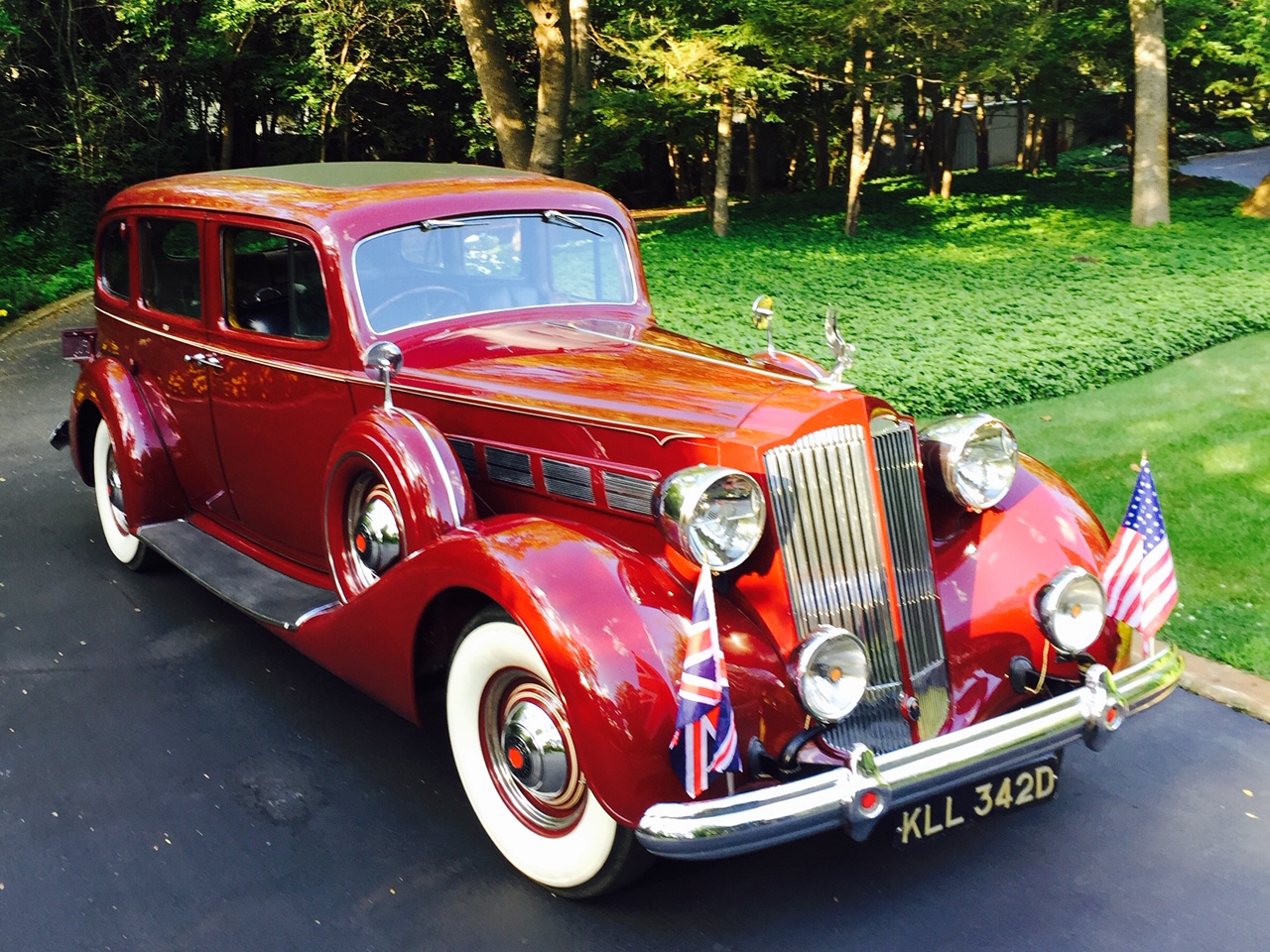Joseph Kennedy 1937 Packard 1502 Limousine
Location: Detroit
VIN #:396799
Engine: Straight 8 319.154 cu in 135HP
Transmission:3 Speed Manual
Wheelbase:139″
Packard was founded by brothers James Ward Packard , William Doud Packard and his partner George Lewis Weiss in the city of Warren, OH. James Ward believed that they could build a better horseless carriage that the Winton cars owned by Weiss (An important Winton stockholder) and James Ward, himself a mechanical engineer, had some ideas how to improve on the designs of current automobiles. By 1899, they were building vehicles. The company, which they called the Ohio Automobile Company, quickly introduced a number of innovations in its designs, including the modern steering wheel and years later the first production 12-cylinder engine. While Ford was producing cars that sold for $440, the Packards concentrated on more upscale cars that started at $2,600. Packard automobiles developed a following not only in the United States, but also abroad, with many heads of state owning them. In need of more capital, the Packard brothers would find it when Henry Joy, a member of one of Detroit’s oldest and wealthiest families, bought a Packard. Impressed by its reliability, he visited the Packards and soon enlisted a group of investors that included his brother-in-law, Truman Newberry. In 1902, Ohio Automobile Company became Packard Motor Car Company, with James as president. Packard moved its automobile operation to Detroit soon after and Joy became general manager and later chairman of the board.. In 1902, Ohio Automobile Company became Packard Motor Car Company, with James as president. Packard moved its automobile operation to Detroit soon after and Joy became general manager and later chairman of the board.
The Packard’s factory on East Grand Boulevard in Detroit was designed by Albert Kahn, and included the first use of reinforced concrete for industrial construction in Detroit. When opened in 1903, it was considered the most modern automobile manufacturing facility in the world and its skilled craftsmen practiced over eighty trades.T he 3.5 million sft plant covered over 35 acres and straddled East Grand Boulevard. It was later subdivided by eighty-seven different companies, has been sitting vacant languishing in disrepair for decades, but is now being restored. Kahn also designed The Packard Proving Grounds at Utica, MI. Throughout the nineteen-tens and twenties, Packard built vehicles consistently were among the elite in luxury automobiles.
The company was commonly referred to as being one of the “Three P’s” of American motordrome royalty, along with Pierce and Peerless. Packard’s leadership of the luxury car field was supreme. Entering into the 1930s Packard attempted to beat the stock market crash and subsequent depression by manufacturing ever more opulent and expensive cars than it had prior to October 1929. The Packard Twin Six was introduced for 1932, and re-named the Packard Twelve for the remainder of its run (through 1939). For one year only, 1932, Packard tried fielding an upper-medium-priced car called the Light Eight. As an independent automaker, Packard did not have the luxury of a larger corporate structure absorbing its losses as Cadillac did with GM and Lincoln with Ford. However, Packard did have a better cash position than other independent luxury marques. Packard also had one other advantage that some other luxury automakers did not; a single production line. By maintaining a single line, and inter-changeability between models, Packard was able to keep its costs down.
Packard did not change cars as often as other manufacturers did at the time. Rather than introducing new models annually, Packard began using its own “Series” formula for differentiating its model change-overs in 1923. New model series did not debut on a strictly annual basis, with some series lasting nearly two years, and others lasting as short a time as seven months. In the long run, though, Packard did average approximately one new series per year. By 1930, Packard automobiles were considered part of the “Seventh Series”. By 1937, Packard was in its “ fifth teen Series”. There never was a “Thirteenth Series”.
This very nice example has led a busy life, having had only 3 owners from new. Delivered new the Leonard Williams Agency in London. Although the US government owned this car it was give to Joseph Kennedy for his exclusive use while ambassador to Great Britain. The second owner was the Canadian Consulate in Toronto. It was eventually sold to a private party who used it for his limo business serving as a vintage vehicle with historical significance in his fleet, I purchased the car at the car corral at the ACCA fall meet from RM Auctions in 1995. The seller was Bill Warner. After a exhausting 22 years restoration and 5 restorations shops the car is now ready for display and service. The recommissioned the car mechanically including a complete nut and bolt engine rebuild. The car enjoys new Indian Red paint, new upholstery, Chrome, tires and wood work refinishing.
Bare Metal Repaint including all new rubber
moldings and window flashings, window rollers replaced, New Glass where needed.
Wiring Harness Overhaul
Radiator reconditioned, New Hoses, New Heater Core
Fuel System Serviced with new Pump and Filter
Vacuum Assist Brake and Clutch rebuilt
Steering Box Adjusted, Shocks Rebuilt
Rear End Serviced, Wiper Motors Rebuilt
6 New Tires and Battery/New Cables and kill switch installed
Wood Work (trim) Refinished, new shades installed.
The car is accompanied by an Owners and Shop Manual.
The car runs and drives without fault. This is the perfect car for club tours and events, and is also very show worthy. This a fully sorted, stunning example of the one of the finest driving Pre War Packards.
